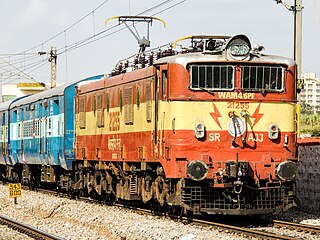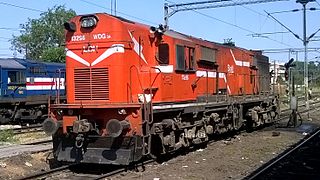Related Research Articles

The Indian locomotive class WDM-2 is a class of diesel-electric locomotive that was developed in 1962 by American Locomotive Company (ALCO) for Indian Railways. The model name stands for broad gauge (W), Diesel (D), Mixed traffic (M) engine, 2nd generation (2). They entered service in 1962. A total of more than 2,700 WDM-2 was built at ALCO and Banaras Locomotive Works, Varanasi between 1962 and 1998, which made them the most numerous class of mainline diesel locomotive until its successor the WDM-3A.

The Indian locomotive class WAM-4 is a class of 25 kV AC electric locomotives that was developed in 1970 by Chittaranjan Locomotive Works for Indian Railways. The model name stands for broad gauge (W), alternating current (A), mixed traffic (M) locomotive, 4th generation (4). They entered service in March 1971. A total of 500 WAM-4 were built at CLW between 1970 and 1983, which made them the most numerous class of mainline electric locomotive till its successor the WAG-5.
The ALCO DL560C is a series of diesel-electric locomotive with AC electric transmission designed by the American Locomotive Company and produced under license by Banaras Locomotive Works (BLW) Varanasi, India for Indian Railways as their classes WDM-2, WDM-3A/2C, WDM-3D and WDG-3A for operation in India. The locomotive is fitted with a 16-cylinder ALCO 251 B,C diesel engine. In the early 1960s Indian Railways needed a reliable diesel workhorse to gradually replace its steam locomotive fleet. Equal numbers of ALCO's DL560C and EMD's G16 were chosen for trials. More locomotives of each of these were purchased for more trials. Indian Railways was keen on producing these locomotives in the country rather than depending on imports. EMD did not agree for a Transfer-of-Technology, while ALCO did. Thus ALCO DL560C was chosen for the job due to its easy maintenance, reliability and simple operation. And from then on vast numbers of this loco in different configurations have been produced and remain the main diesel traction power of Indian Railways.
Barddhaman Junction Railway Station is a railway junction station on the Howrah–Delhi main line and is located in Purba Bardhaman District in the Indian state of West Bengal. EMU services from Howrah along Howrah–Bardhaman main line and Howrah–Bardhaman chord terminate at Bardhaman. Every day, over 300 express/mail/SF trains halt here, making it one of the busiest and important junction railway station in Eastern India. It serves Bardhaman, the fifth most populous city in West Bengal.

The Indian locomotive class WDM-4 is a class of diesel-electric locomotive that was developed in 1962 by Electro-Motive Diesel for Indian Railways. The model name stands for broad gauge (W), Diesel (D), Mixed traffic (M) engine, 4th generation (4). They entered service in 1962. A total of 72 WDM-4 locomotives were built between 1961 and 1962.

The WDM-1 was the first class of Wide Gauge (W), Diesel powered (D), Mixed load (M), meant for hauling both freight and passenger trains. These are also the first mainline diesel engines imported after Independence. They were even the fastest diesel locomotives till the advent of WDM 2 and WDM 4. They used to haul ore/freight trains on SER. In the end, they were relegated to shunting/piloting duties or hauling sugarcane freight trains. One unit, #17000, is preserved at National Rail Museum, Delhi.

The Indian locomotive class WDM-3D is a class of diesel-electric locomotive that was developed in 2003 by Banaras Locomotive Works (BLW), Varanasi for Indian Railways. The model name stands for broad gauge (W), Diesel (D), Mixed traffic (M) engine with 3300 horsepower (3D). The engine is classified WDM-3D though it outputs only 3300 hp and not 3400 hp as the name should suggest. They entered service in 2003. A total of 590+ WDM-3D were built at Banaras Locomotive Works (BLW), Varanasi between 2003 and 2016.

The WDM-7 is a diesel-electric locomotive of Indian Railways. It has been manufactured by Banaras Locomotive Works (BLW), Varanasi. The model name stands for broad gauge (W), diesel (D), mixed traffic (M) engine. Today, these are found exclusively at Chennai Central and nearby area.

The Indian locomotive class WDG-3A is a class of diesel-electric locomotive that was developed in 1994 by Banaras Locomotive Works (BLW),Varanasi for Indian Railways. The model name stands for broad-gauge (W), Diesel (D), Goods traffic (G) engine, 3,100 hp (3A) locomotive. They entered service on 18 July 1995. A total of 1,164 WDG-3A units were built between 1994 and 2015 at BLW, Varanasi with a few units being produced by Diesel Loco Modernisation Works (DLMW) and Parel Workshop.

The Indian locomotive class WAM-1 was a class of 25 kV AC electric locomotives that was developed in the late 1950s by the Groupement 50Hz for Indian Railways. The model name stands for broad gauge (W), AC Current (A), Mixed traffic (M) locomotive, 1st generation (1). They entered service in 1960 thus making them India's first AC electric locomotive. A total of 100 WAM-1 were built by the European consortium between 1959 and 1961, which made them the most numerous class of mainline electric locomotive until the WAG-1.
The Indian locomotive class WDS-6 is a diesel-electric locomotive used by the Indian Railways mainly for shunting and also for performing departmental duties. The model name stands for broad gauge (W), Diesel (D), Shunting (S) engine, 6th generation (6). As of April 2022, 375 units of this class are currently in use all over India.

The WDS-4 also known as Pappu is a class of diesel-hydraulic locomotive used by Indian Railways for shunting and departmental operations. The model name stands for broad gauge (W), Diesel (D), Shunting (S) engine. The WDS-4 was once used all over India but most have now been scrapped or condemned from active service.

The Indian locomotive class WDM-3 is a type of diesel-hydraulic locomotive that was developed by Henschel for Indian Railways in 1962. The model name "WDM-3" stands for broad gauge (W), Diesel (D), Mixed traffic (M) engine, 3rd generation (3). These locomotives were put into service between 1970 and 1971, and a total of eight were built between 1962 and 1970. However, they were decommissioned at Gooty in 1995 and are now retired from service.

The Indian locomotive class YDM-1 is a class of diesel-Hydraulic locomotive that was developed in 1954 by North British Locomotive Company (NBL) for Indian Railways. The model name stands for Metre gauge (Y), Diesel (D), Mixed traffic (M) engine, 1st generation (1). They entered service in 1955. A total of 20 YDM-1 locomotives was built between 1954 and 1956, which made them among the first MG main-line diesels.

The Indian locomotive class YDM-5 is a class of diesel-electric locomotive that was developed in 1964 by General Motors (GM-EMD) for Indian Railways. The model name stands for Metre gauge (Y), Diesel (D), Mixed traffic (M) engine, 5th generation (5). They entered service in 1964. A total of 25 YDM-5 locomotives was built between 1963 and 1964.

The Indian locomotive class YDM-3 is a class of diesel-electric locomotive that was developed in 1964 by GM-EMD for Indian Railways. The model name stands for Metre gauge (Y), Diesel (D), Mixed traffic (M) engine, 3rd generation (3). They entered service in 1962. A total of 30 YDM-3 locomotives was built between 1961 and 1962.

Diesel Loco Shed, Tondiarpet is a motive power depot performing locomotive maintenance and repair facility for diesel locomotives of the Indian Railways. It is located near Tondiarpet railway station (TNP) of the Southern Railway zone in the city of Chennai, Tamil Nadu and is one of the four diesel loco sheds of the Southern Railway, the others being at Ernakulam (ERS) at Kochi, Erode (ED) and Golden Rock (GOC) at Trichy.
The WDM-2G is a class of diesel electric genset locomotive used in Indian Railways. It is one of the rarest locomotives in India with only two units being produced by Patiala Locomotive Works (PLW). The locomotives were produced with an intention of being fuel efficient and to be used for light to medium duties such as short passenger runs along with occasional shunting. They are one of the only two classes of locomotives in India to feature multiple prime movers, the other example being WDS-6G, which was designed solely for shunting. They have a rated power of 2,400 HP.

The class WDS-3 was a diesel-electric locomotive used by Indian Railways for shunting and doing departmental works. The model name stands for broad gauge (W), Diesel (D), Shunting (S) 3rd generation (3). The WDS-3 is used mostly in the Northern Railway Zone (NR). All these locomotives were withdrawn by the late 1990s.

The Indian locomotive class WDS-8 is a class of diesel-electric locomotive that was developed in 1979 by the Chittaranjan Locomotive Works for Indian Railways, but ended up being delivered exclusively to the private sector. The model name stands for broad gauge (W), Diesel (D), Shunter (S) engine, 8th generation (8). They entered service in 1979. A total of five WDS-8 locomotives was built at Chittaranjan Locomotive Works (CLW), Chittaranjan between 1979 and 1982.
References
- ↑ "[IRFCA] Indian Railways Locomotive Roster Barddhaman, Burdwan (BWN) WDM-6 18901 Show". www.irfca.org. Retrieved 5 June 2020.
- ↑ "[IRFCA] Indian Railways Locomotive Roster Barddhaman, Burdwan (BWN) WDM-6 18902 Show". www.irfca.org. Retrieved 5 June 2020.
Bibliography
- Hughes, Hugh (1996). Indian Locomotives: Part 4 – 1941–1990. Harrow, Middlesex: The Continental Railway Circle. ISBN 0-9521655-1-1. OCLC 35135033.



